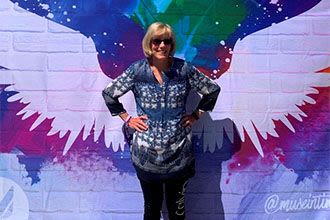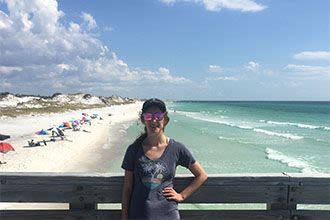How many pairs of sunglasses do people have?

How many pairs of sunglasses do you need? That depends on your fashion sense, your budget and your various activities.
For example, people wear shades to block the sun's rays or to see better while playing sports, and fashionistas wear sunglasses to be seen (and sometimes not to be seen by the paparazzi).
We asked people how many sunglasses they need — and their answers spotlight three reasons people often have more than one pair: sun protection, performance enhancement (think sports and hobbies) and, of course, as a fashion statement.
A fourth reason people have more than one pair of sunglasses? Additional pairs of shades are backups for when sunglasses go missing, as they so often seem to do.
Sunglasses shield your eyes from the sun
When the prehistoric Inuits of the Arctic first fashioned primitive sunglasses by carving narrow slits in walrus ivory, they were looking for relief from snow blindness. Protection from environmental factors is no less important today, but the delivery system has vastly improved.
While general awareness that the sun’s ultraviolet (UV) radiation is extremely harmful to the skin is on the rise, many people do not realize that the sun also presents a serious danger to their vision.

Paul Ronto wears sunglasses while riding a mountain bike.
Accumulated UV exposure can heighten the risk of cataracts and macular degeneration later in life, cause photokeratitis (sunburn of the eye) and disfiguring growths on the eye (pterygium or surfer's eye) that cause blurry vision and discomfort, as well as several kinds of eye cancer.
Wearing protective sunglasses with a UV rating is the first line of defense against both short- and long-term eye damage related to the sun.
“While everyone can potentially suffer these conditions, children and people with light-colored eyes should be especially careful since their eyes may be more susceptible to damage from the sun’s rays,” notes the American Academy of Ophthalmology (AAO).
Paul Ronto of Fort Collins, Colorado, has a lot of sunglasses because his green eyes have always been light sensitive, but even more so since he had LASIK surgery 10 years ago. An outdoorsy guy, he admits to having at least 20 pairs of tinted lenses, and he favors those that offer UV protection and wraparound frames for side view protection.
“I’m a big advocate for having the right gear for the job, and that means I have shades for mountain biking, running, rafting, fishing, plus casual shades, some fun ones, and some extras,” says Ronto, the chief marketing officer of athletic footwear review site RunRepeat.
“It’s excessive to have this many pairs, but I feel like I can’t see without them,” he says. “I squint and my face gets tired, my eyes get tired. Sunglasses are a pretty easy solution.”
And sunglasses that protect your eyes don’t have to be expensive to be effective, the AAO notes. More affordable pairs marked “100% UV-blocking” work just as well.
ADDING TO YOUR SUNGLASSES COLLECTION? Shop for jazzy shades at an optical store near you or an online eyewear retailer.
Sunglasses can up your visual game
Today’s innovative prescription and non-prescription (plano) sports sunglasses provide the best vision possible under variable conditions. A broad range of lens tints is available, designed to increase contrast and visual acuity under different light conditions while delivering optimal color perception.
Adding an anti-reflective coating to the back surface of the lenses also helps to eliminate glare and protect vision.

Lynell Ross sports one of her pairs of sunglasses in front of a mural.
Certified health and wellness coach Lynell Ross from Auburn, California, owns five pairs of plano sunglasses plus two pairs of prescription glasses with photochromic lenses that transition to sunglasses. Those five pairs meet all of her activity needs.
“I have one pair that I wear for yoga or running because they fit so well. One pair is just for hiking because they cover more face area to protect from the sun, which helps when hiking at high altitudes on long days,” the managing editor of Zivadream.com says.
“The polarized lenses reduce glare and protect my eyes from UV rays. And the Transitions lenses are very convenient to wear for daily use when going from the office to running errands.”
Sunglasses as a fashion statement
No discussion of sunglasses is complete without mentioning their magical ability to lift us (at least in our imagination) from the mundane to the sublime just by slipping them on.

Dave Bowden says he sometimes plans his outfits for the day around the sunglasses he intends to wear.
Or, as one famous celebrity succinctly said of himself, “With my sunglasses on, I’m Jack Nicholson. Without them, I’m fat and 60.”
Self-professed sunglasses fanatic and Toronto-based men’s style blogger Dave Bowden considers his ever-growing collection to be an extension of his wardrobe.
“I wouldn’t say my image is based on my shades, though I’ve been guilty of planning my outfits for the day around the sunglasses I intend to wear,” he admits.
While confessing to having dropped $300 on an Italian luxury eyewear brand, Bowden notes that price doesn’t always buy value. One of his favorite pairs cost less than $90.

Stacy Caprio chooses her sunglasses to match her mood. Sometimes she wants to stand out and sometimes she wants to blend in, she says.
Coordinating frames with fashion is certainly one way to go, but Stacy Caprio of Chicago says her selection is often more mood-related.
“I wear my mirrored pink fluorescents when I want to be stylish or when it fits the occasion, and I put on my brown Ray-Bans when I want to blend in or look normal,” she says.
Her max spend on a pair of non-prescription sunnies is $200, although she usually tries to shell out less than half that.
Several pairs for when sunglasses go missing
Looking up into the sun is just part of the job for painting contractor Jeff Neal of Capital Coating in Lancaster, Pennsylvania, so he keeps his truck well stocked with UV protection sunglasses that he buys in bulk at a national home improvement retailer.

Jeff Neal needs sunglasses for work, so he keeps several pairs of shades in his truck.
“Sunglasses are critical to prevent the sun from blinding me when I assess surface and access conditions,” he says. “I have so many sunglasses because I always misplace them from all the traveling I do between job sites, home and office.”
How to get the best sunglasses for UV protection
Whatever your need for sunglasses, the American Optometric Association (AOA) recommends choosing a pair that blocks 100% of both UVA and UVB radiation, and they should screen out 75% to 90% of visible light.
Finally, to ensure that your new sunglasses provide the best vision possible, invest in a comprehensive eye exam with an eye care professional. Get an updated prescription, if necessary, and ask your eye doctor or optician for guidance on choosing the best sunglasses for your particular needs.
EYEING ANOTHER PAIR OF SUNGLASSES? Shop for sunglasses at an optical store near you or an online eyewear retailer.
Page published on Thursday, February 13, 2020




